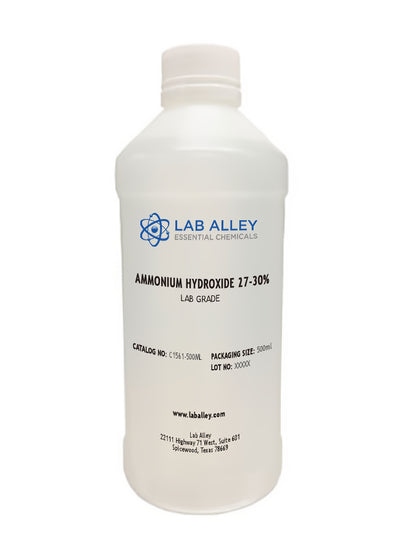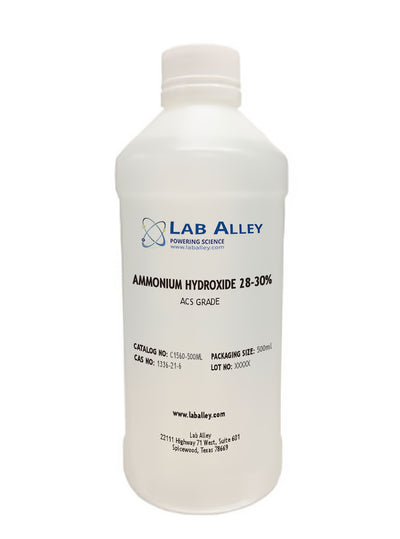
Business Support
Ammonium Hydroxide 1M Solution
Ideal For Chromatography, Titration, And Volumetric Solutions
For questions regarding lead time, please contact a member of our Customer Care Team at customercare@laballey.com
Business Support
Description
About Ammonium Hydroxide 1M Solution
Ammonium Hydroxide, NH4OH, is formed when ammonia (NH3) is dissolved in water. Ammonia deprotonates a small portion of water molecules leaving the free hydroxide ion, [OH]-, to form a slightly basic solution. The resulting solution is clear, colorless, with a pungent odor and vapors that may irritate the eyes.
Ammonium Hydroxide, 1.0 M solution is prepared by mixing 6.19 mL of Ammonium Hydroxide solution (56% w/w) in 100 mL deionized water. It appears as colorless liquid and having no odor at room temperature. For the measurement of total iodine (m/z 127) in baby formula and adult nutritional goods, an ammonium hydroxide solution is utilized to create a single-laboratory validation using inductively coupled plasma-mass spectrometry. Lab Alley’s Ammonium Hydroxide, 0.1N is ideal for routine lab activities involving chromatography, analytical reagents, titration and volumetric solutions.
COMMON USES AND APPLICATIONS
- Chromatography
- Analytical reagent
- Titration
INDUSTRIES
PRODUCT INFORMATION
Customer Reviews and Q&A
Safety and Shipping
Please contact us to request a Safety Data Sheet (SDS) and Certificate of Analysis (COA) for Ammonium Hydroxide 1M Solution.
Business Support
Built for Business.
At Lab Alley, we simplify procurement with custom quotes, credit applications, tax exemptions, and fulfillment support, ensuring on-budget, on-time delivery - your success is our priority.
Apply for Credit
A Lab Alley credit account streamlines purchasing for your business. Our Customer Success Team is available to help you through every step of the process.
Request a Custom Quote
Get a fast, customized quote tailored to your specific needs. Our team ensures accurate pricing and availability to help streamline your purchasing process.

Additional Business Resources
Lab Alley provides access to essential certifications, documents, and other resources to support your business.

Create a Lab Alley Account

RECEIVE exclusive offers, promotions, and discounts on chemicals.

Always have the product you need, when you need it with our AUTOSHIP program.










